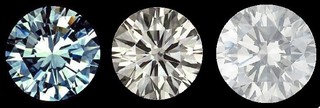Diamond brilliance refers to the amount of white light that is reflected from a diamond. It is one of the most important qualities that contribute to a diamond’s overall sparkle and appeal. Brilliance is primarily determined by how well the diamond has been cut, as this affects how light enters, reflects, and exits the stone.
Key Factors Contributing to Diamond Brilliance:
Cut Quality:
The cut of the diamond plays a crucial role in determining its brilliance. The diamond must be cut with the correct proportions, angles, and symmetry to allow light to enter and reflect in a way that maximizes brilliance.
A well-cut diamond will have facets that act like mirrors, reflecting light back to the viewer’s eye, creating that characteristic sparkle. A poorly cut diamond, on the other hand, will allow light to escape from the sides or bottom, reducing its brilliance.
Proportions and Symmetry:
The proportions of a diamond, such as the depth, table size, and crown angle, directly affect how light travels through the stone. A diamond with ideal proportions will allow light to reflect optimally and produce maximum brilliance.
Symmetry ensures that all the facets are aligned properly, which helps in the even distribution of light reflections.
Clarity:
While clarity (the presence of inclusions or blemishes) does not directly affect a diamond’s brilliance, it can influence how well light is reflected. Inclusions can scatter light inside the diamond, reducing the intensity of reflections. Diamonds with higher clarity typically exhibit greater brilliance.
Colour:
A diamond’s colour can also affect its brilliance. Colourless diamonds (graded D to F on the GIA scale) tend to reflect light better and show more brilliance compared to diamonds with noticeable colour. However, diamonds with a slight tint (G to J) can still have good brilliance, especially when they are well-cut.
Light Performance:
Brilliance is a part of a diamond’s light performance, which also includes other effects like fire (the dispersion of light into colours) and scintillation (the sparkle seen when the diamond is moved). Brilliance refers specifically to the white light reflection from the diamond.
Environmental Lighting:
The environment in which a diamond is viewed also influences its perceived brilliance. Natural sunlight or strong artificial light can enhance a diamond’s sparkle, while dim lighting or poorly lit environments may make the diamond appear duller.
When viewed under different types of lighting, such as incandescent or fluorescent, the diamond’s brilliance may vary slightly, but the overall cut and quality will still play a significant role in how it performs in terms of sparkle.
Brilliance vs. Fire and Scintillation:
Fire refers to the dispersion of light into the colours of the rainbow, and scintillation is the flashes of light that occur when the diamond is moved. While these contribute to the overall visual appeal of a diamond, brilliance is focused solely on the white light that the diamond reflects.
All three factors—brilliance, fire, and scintillation—work together to give a diamond its characteristic sparkle, with brilliance being the most noticeable when the diamond is at rest.
How Brilliance is Measured:
Diamond grading labs like GIA (Gemological Institute of America) assess a diamond’s brilliance by examining how light interacts with the diamond’s facets.
Brilliance score is often a part of overall cut quality grading, but some advanced tools and technologies (like Ideal-Scope and Aset tools) can help buyers visually assess a diamond’s brilliance by simulating how it will reflect light in different conditions.

